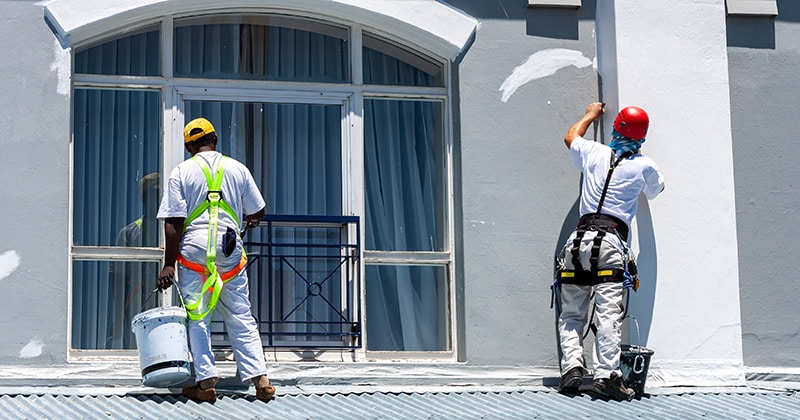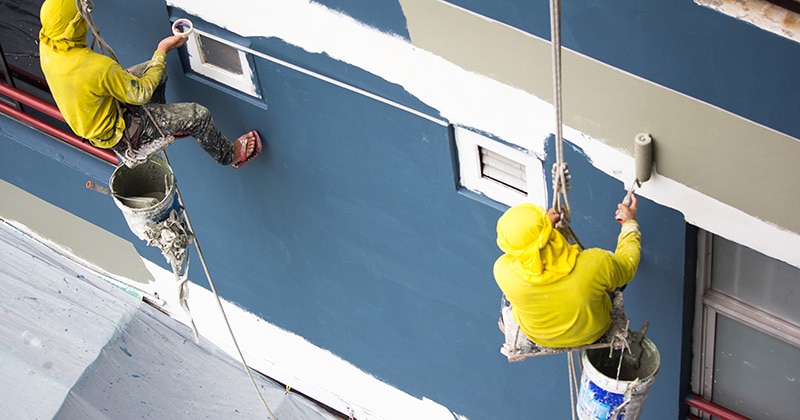Every painter’s been there: staring at a blank estimate sheet, trying to boil a complex painting job down to a simple number. It’s like solving a puzzle. But breaking down your painting estimate into simple pieces makes the whole job a lot more manageable.
In this guide, you’ll learn how to put those pieces together. From labor costs to gallons of paint, here’s how to bid commercial painting jobs with ease.
RELATED ARTICLE — Painting Leads 101: Effective Ways to Boost Your Business
What Is a Commercial Painting Bid?

A commercial painting bid is your project’s blueprint in numbers. While a quick painting estimate might work for a bedroom, commercial painting jobs need a lot more detail. Your bid tells clients exactly what they’ll get and what they’ll pay, so there are no surprises for anyone.
Breaking down a bid for a painting job is a little like writing a recipe. First, you list all the ingredients—the materials. These include how many gallons of paint you’ll need, the supplies you’ll use, and any special materials the job requires.
Some painting jobs have strict requirements about materials. Maybe you need a special type of exterior paint for outdoor surfaces or industrial coatings for certain areas. These details matter, especially in commercial painting where standards are extra high.
Then comes the biggest part of your recipe: labor costs. How many painters will you need? How long will the prep work take? Getting it right is essential. After all, proper prep work can make the difference between a painting job that lasts for years and one that needs touching up after just a few months.
Timing is another critical ingredient. Commercial painting jobs often need to dance around business hours and other construction schedules. Your timeline should spell out when you’ll start, how long each phase will take, and when you’ll wrap it all up. Having a schedule helps keep everyone in sync.
The business side of your bid needs attention too. This is your safety net, so it should include everything a painting contractor needs to consider to pull off the perfect painting job. This means:
- Safety plans to protect your team and others
- Insurance coverage to protect everyone involved
- Any permits you need for the work
- Quality control measures to ensure great results
- Warranty details that give your client peace of mind
When your bid is comprehensive, it acts as a shield, protecting both you and your client from misunderstandings. It puts everyone on the same page before even cracking open the first gallon of paint.
RELATED ARTICLE — How To Start a Painting Business: 7 Essential Steps
Residential Versus Commercial Painting

A painting job is a painting job, right? Not quite. While residential and commercial painting might use similar materials and methods overall, the jobs themselves are pretty different. Here are some of the differences:
- Size. The most obvious difference is physical size. Instead of a few rooms in a house, commercial painting jobs often cover entire buildings. That means your bid needs a whole new game plan.
- Bid Complexity. A homeowner might be fine with a simple painting estimate and a friendly chat. But commercial painting clients want everything in writing. They expect a clear breakdown of labor costs and prep work, and they need to see reliable start and end dates.
- Planning. Commercial painting jobs also need extra planning. You might have to work at night when offices are empty. Or your painters might need to work alongside other contractors. This requires more logistical maneuvering.
- Tools. A residential painting job might only need basic ladders and brushes. But commercial painting contractors often need more heavy-duty equipment. Your bid should include costs for things like scaffolding or lift rentals. If you’re doing exterior paint work on tall buildings, you’ll need even more specialized gear.
- Paint Types. The paint can be different for commercial work. Many buildings have specific rules about the types you can use. Some need extra-tough paint that lasts longer. Your painting crew might need different tools to apply it too. All of this affects both your paint costs and your labor costs, so make sure your bid covers everything.
- Communication. With a house, you usually chat directly with the owner. But commercial painting jobs typically involve talking with building managers or committees. Your bid needs to show them that your painting business understands what they need and how to deliver it.
FROM ONE OF OUR PARTNERS — How To Improve Profit Margins for Painting Companies
7 Steps To Bid on a Commercial Painting Job

Whether you want to bid on interior commercial painting jobs or any other kind, winning a job takes planning. Each step helps you catch details that could affect your costs.
Here’s how to bid a paint job and break it down into manageable pieces:
1. Review the Bid Documents
Start with a close look at what the client wants. Read through all the requirements carefully, paying special attention to deadlines and any special conditions. Look for specific paint types they request. This is also when you calculate square footage from their plans. Every detail matters for an accurate bid.
2. Visit the Site
Never skip the site visit. Walk through the property with the building manager to get all the details right. This is your chance to spot things that might not show up in the documents.
Measure each area yourself to confirm the square footage. Check access points for your painters and equipment, and look for areas that might need extra prep work. Don’t forget to take lots of pictures to help you when you’re sitting down to put your bid together.
3. Calculate Materials
Figure out exactly how much primer and how many gallons of paint you’ll need. Start with your square footage and divide by how much area each gallon covers. And don’t forget about second—or even third—coats.
RELATED RESOURCE — Painting Cost Calculator
4. Add Up Equipment Costs
List every piece of equipment the job needs. Will you need scaffolding? Lifts? Specialized sprayers? Include rental costs in your bid if you don’t own the equipment. Factor in transportation costs for getting everything to the site.
5. Figure Out Your Labor Needs
This is where you plan your crew. How many painters will you need? How long should prep work take? Consider special skills needed for different parts of the paint job. Make sure your labor costs include time for setup and teardown each day.
6. Consider the Timeline and Logistics
Map out your project schedule. When can you start? How long will each phase take? Think about working hours and site access. Your bid should show exactly when you’ll enter and paint different areas.
7. Review and Finalize
Double-check all your numbers. Make sure you’ve included overhead costs for your painting business. Add in your profit margin, then put it all together in a clear, professional bid that shows the client exactly what they’re getting.
RELATED ARTICLE — Free Painting Invoice Template and Tips
3 Tips To Bid on Commercial Painting Jobs

No matter where a bid on painting jobs happens, these three tips will help yours stand out from the pack:
- Know Your Competition. Every painting business has its own way of bidding. Some focus on low prices, while others focus on speed or premium service. Explore what other painters in your area typically charge for similar paint jobs. This helps you bid competitively while still making a profit.
- Read the Fine Print. Missing a requirement in the bid documents can cost you the job. Check for specific insurance needs, and look at payment terms carefully. Note any special conditions related to prep work or cleanup.
- Create Professional Documentation. Your estimates and bids are often a client’s first impression of your business, so make them count. Use clean, consistent formatting for all your paperwork. Organize your painting estimates clearly, with separate sections for labor costs and materials. When your documents look polished, clients trust that your paint jobs will be too.
RELATED ARTICLE — How to Estimate a Paint Job in 7 Easy Steps
Win More Clients With Quick and Professional Estimates From Joist
Turn your bidding strategies into action with professional, ready-to-send estimates right from your phone. It all starts with Joist.
Create and share estimates in just minutes with Joist’s easy-to-use mobile estimating tool. Packed with powerful features built for contractors, you’ll never miss a beat—whether you’re on the job or at home.